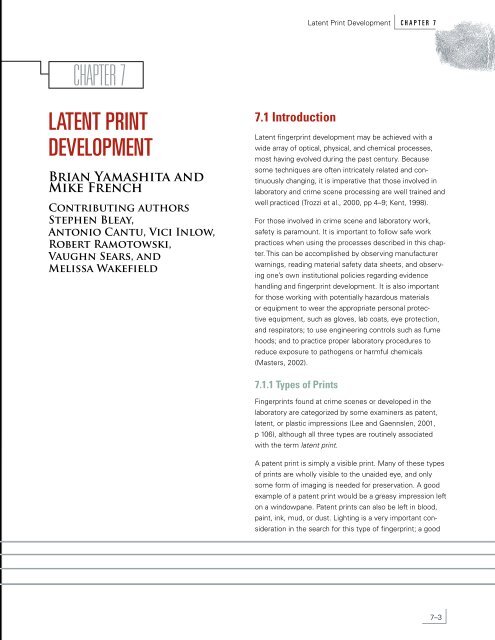Latent Print Development - National Criminal Justice Reference ...
Latent Print Development - National Criminal Justice Reference ...
Latent Print Development - National Criminal Justice Reference ...
Create successful ePaper yourself
Turn your PDF publications into a flip-book with our unique Google optimized e-Paper software.
CHAPTER 7<br />
LATENT PRINT<br />
DEVELOPMENT<br />
Brian Yamashita and<br />
Mike French<br />
Contributing authors<br />
Stephen Bleay,<br />
Antonio Cantu, Vici Inlow,<br />
Robert Ramotowski,<br />
Vaughn Sears, and<br />
Melissa Wakefield<br />
7.1 Introduction<br />
<strong>Latent</strong> fingerprint development may be achieved with a<br />
wide array of optical, physical, and chemical processes,<br />
most having evolved during the past century. Because<br />
some techniques are often intricately related and continuously<br />
changing, it is imperative that those involved in<br />
laboratory and crime scene processing are well trained and<br />
well practiced (Trozzi et al., 2000, pp 4–9; Kent, 1998).<br />
For those involved in crime scene and laboratory work,<br />
safety is paramount. It is important to follow safe work<br />
practices when using the processes described in this chapter.<br />
This can be accomplished by observing manufacturer<br />
warnings, reading material safety data sheets, and observing<br />
one’s own institutional policies regarding evidence<br />
handling and fingerprint development. It is also important<br />
for those working with potentially hazardous materials<br />
or equipment to wear the appropriate personal protective<br />
equipment, such as gloves, lab coats, eye protection,<br />
and respirators; to use engineering controls such as fume<br />
hoods; and to practice proper laboratory procedures to<br />
reduce exposure to pathogens or harmful chemicals<br />
(Masters, 2002).<br />
7.1.1 Types of <strong>Print</strong>s<br />
<strong>Latent</strong> <strong>Print</strong> <strong>Development</strong> C H A P T E R 7<br />
Fingerprints found at crime scenes or developed in the<br />
laboratory are categorized by some examiners as patent,<br />
latent, or plastic impressions (Lee and Gaennslen, 2001,<br />
p 106), although all three types are routinely associated<br />
with the term latent print.<br />
A patent print is simply a visible print. Many of these types<br />
of prints are wholly visible to the unaided eye, and only<br />
some form of imaging is needed for preservation. A good<br />
example of a patent print would be a greasy impression left<br />
on a windowpane. Patent prints can also be left in blood,<br />
paint, ink, mud, or dust. Lighting is a very important consideration<br />
in the search for this type of fingerprint; a good<br />
7–3

















